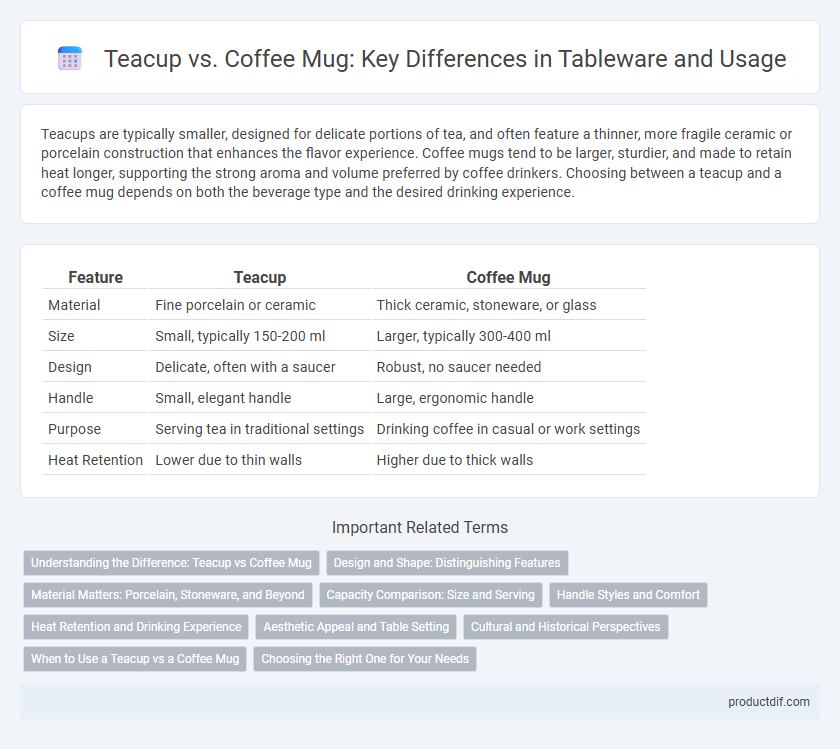Teacups are typically smaller, designed for delicate portions of tea, and often feature a thinner, more fragile ceramic or porcelain construction that enhances the flavor experience. Coffee mugs tend to be larger, sturdier, and made to retain heat longer, supporting the strong aroma and volume preferred by coffee drinkers. Choosing between a teacup and a coffee mug depends on both the beverage type and the desired drinking experience.
Table of Comparison
| Feature | Teacup | Coffee Mug |
|---|---|---|
| Material | Fine porcelain or ceramic | Thick ceramic, stoneware, or glass |
| Size | Small, typically 150-200 ml | Larger, typically 300-400 ml |
| Design | Delicate, often with a saucer | Robust, no saucer needed |
| Handle | Small, elegant handle | Large, ergonomic handle |
| Purpose | Serving tea in traditional settings | Drinking coffee in casual or work settings |
| Heat Retention | Lower due to thin walls | Higher due to thick walls |
Understanding the Difference: Teacup vs Coffee Mug
Teacups typically feature a delicate, thin porcelain design with a smaller capacity of about 6 ounces, enhancing the aroma and flavor of brewed tea. Coffee mugs are sturdier, often made of ceramic, with larger volumes ranging from 10 to 16 ounces to accommodate coffee's stronger, hotter serving style. Understanding these distinctions helps optimize the drinking experience based on beverage temperature, flavor concentration, and cultural preferences.
Design and Shape: Distinguishing Features
Teacups typically feature a delicate, thin-walled design with a wide brim and a small, elegant handle, optimized for sipping delicate teas and enhancing aroma. Coffee mugs are generally thicker, sturdier, and have a cylindrical shape with a larger handle, designed to retain heat longer and accommodate larger beverage volumes. The shape of teacups promotes cooling and refinement, while coffee mugs emphasize functionality and thermal insulation.
Material Matters: Porcelain, Stoneware, and Beyond
Porcelain teacups offer a delicate, heat-retentive quality ideal for refining the subtle flavors of tea, while stoneware coffee mugs provide durability and insulation suited for heavier brews. Materials like bone china enhance translucency and elegance in teacups, contrasting with ceramic and glass options common in coffee mugs that balance practicality with style. Understanding the thermal properties and aesthetic appeal of these materials influences the choice between a teacup and coffee mug for different beverage experiences.
Capacity Comparison: Size and Serving
Teacups typically hold between 4 to 6 ounces, designed for smaller servings of tea to preserve its delicate flavors and temperature. Coffee mugs usually range from 8 to 16 ounces, accommodating larger volumes to suit longer drinking sessions and stronger brews. The size difference reflects their distinct serving purposes, with teacups favoring elegance and measured portions, while mugs prioritize practicality and capacity.
Handle Styles and Comfort
Teacup handles are typically dainty and designed for a delicate grip, enhancing elegance and control during sipping, whereas coffee mug handles are larger and ergonomically shaped to accommodate a full hand, prioritizing comfort and stability. The smaller teacup handle often suits lighter ceramic or porcelain, promoting a refined experience, while coffee mug handles are robust, supporting thicker walls and heavier weight for everyday use. Comfort in teacups emphasizes finesse and posture, while coffee mugs focus on ease of hold and endurance during longer drinking sessions.
Heat Retention and Drinking Experience
Teacups typically have thinner walls made of porcelain or bone china, which allows beverages to cool faster, providing a more delicate sipping experience ideal for tea. Coffee mugs, often crafted from thicker ceramic or insulated materials, excel in heat retention, maintaining temperature longer for a robust coffee experience. The shape and size of each vessel also influence aroma release and flavor perception, with teacups enhancing subtle notes while coffee mugs support a richer taste profile.
Aesthetic Appeal and Table Setting
Teacups often feature delicate designs and elegant shapes that enhance the aesthetic appeal of a formal table setting. Coffee mugs tend to have a more robust and casual appearance, making them suitable for relaxed or everyday use. Selecting teacups or coffee mugs significantly influences the overall ambiance and style of the dining experience.
Cultural and Historical Perspectives
Teacups, traditionally associated with formal tea ceremonies in East Asia and Europe, symbolize elegance and ritualistic social interactions. Coffee mugs, originating from the American and European coffeehouse culture, emphasize practicality and casual daily use. Both reflect distinct cultural values, with teacups embodying refinement and coffee mugs representing convenience and modern lifestyle.
When to Use a Teacup vs a Coffee Mug
Teacups are best suited for formal occasions or traditional tea ceremonies, offering a delicate design that enhances the aroma and temperature of tea. Coffee mugs provide practicality and durability for everyday use, with larger capacity and insulated walls that keep coffee hot longer. Choosing between a teacup and a coffee mug depends on the beverage type, serving style, and setting, with teacups emphasizing elegance and mugs prioritizing convenience.
Choosing the Right One for Your Needs
Teacups are designed with thin walls and a delicate shape to enhance the aroma and flavor of tea, making them ideal for traditional tea ceremonies and light sipping. Coffee mugs typically have thicker walls and larger volumes, providing better heat retention for stronger, hotter brews and a comfortable grip for everyday use. Selecting between a teacup and coffee mug depends on beverage type, heat retention preference, and ergonomic design tailored to your drinking habits.
Teacup vs Coffee Mug Infographic

 productdif.com
productdif.com